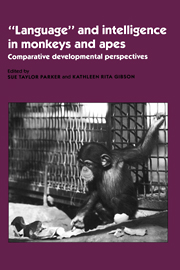Book contents
- Frontmatter
- Contents
- List of contributors
- Foreword
- Preface
- Acknowledgments
- Part I Theoretical frameworks for comparative developmental studies
- Part II Comparative developmental perspectives on cebus intelligence
- Part III Questions regarding imitation, “language,” and cultural transmission in apes and monkeys
- Part IV Developmental perspectives on social intelligence and communication in great apes
- Part V Development of numerical and classificatory abilities in chimpanzees and other vertebrates
- Part VI Comparative developmental perspectives on ape “language”
- 19 The cognitive foundations for reference in a signing orangutan
- 20 Grammatical combination in Pan paniscus: Processes of learning and invention in the evolution and development of language
- Index
20 - Grammatical combination in Pan paniscus: Processes of learning and invention in the evolution and development of language
Published online by Cambridge University Press: 11 May 2010
- Frontmatter
- Contents
- List of contributors
- Foreword
- Preface
- Acknowledgments
- Part I Theoretical frameworks for comparative developmental studies
- Part II Comparative developmental perspectives on cebus intelligence
- Part III Questions regarding imitation, “language,” and cultural transmission in apes and monkeys
- Part IV Developmental perspectives on social intelligence and communication in great apes
- Part V Development of numerical and classificatory abilities in chimpanzees and other vertebrates
- Part VI Comparative developmental perspectives on ape “language”
- 19 The cognitive foundations for reference in a signing orangutan
- 20 Grammatical combination in Pan paniscus: Processes of learning and invention in the evolution and development of language
- Index
Summary
In 1979, Terrace, Petitto, Sanders, and Bever asked “Can an Ape Create a Sentence?” Looking at the evidence from a syntactic, semantic, and conversational point of view, their answer was no. Their conclusion was based on evidence from their own research with a common chimp, Nim Chimpsky, as well as on their analysis of data from other studies of ape language (Gardner & Gardner, 1973; Nova, 1976; Premack, 1976; Rumbaugh, 1977). Our goal in this chapter is to demonstrate that with a different species, the bonobo or pygmy chimpanzee, under a different set of conditions, the answer can be yes.
The study of ape language is important in establishing the evolutionary roots of human language. This is a subject on which there has been tremendous controversy (Bronowski & Bellugi, 1970; Limber, 1977; Petitto & Seidenberg, 1979; Seidenberg & Petitto, 1979; Terrace et al., 1979; Terrace, Petitto, Sanders, & Bever, 1980; Terrace, 1983). Is human language unique? Is it in any sense discontinuous from all that has preceded it in evolution? (See Vauclair, P&G11.) Or can we find the evolutionary roots of human language in the linguistic capacities of the great apes?
The human being is a unique species, but so is each species. In addition to being unique, we have an evolutionary history. Our physical characteristics and our behavior have evolved over long periods of time.
Evolution is conservative: It modifies the material that already exists and builds on it.
- Type
- Chapter
- Information
- 'Language' and Intelligence in Monkeys and ApesComparative Developmental Perspectives, pp. 540 - 578Publisher: Cambridge University PressPrint publication year: 1990
- 98
- Cited by



